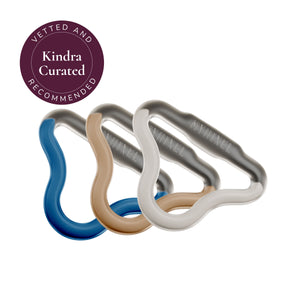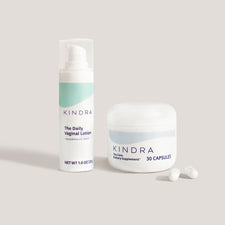For many women, menopause can feel like a liberating time. You no longer have to deal with periods or worry about getting pregnant, and it often coincides with exciting life changes like career advancement and having kids become older and more independent. But there’s one thing that can make you feel like all of these exciting gains are for naught, and that’s painful intimacy before, after, and even during your menopause transition.
Unfortunately, painful sex after menopause is common for far too many women. The changes that happen to your body during the menopause transition can make sex as you once knew it (and enjoyed it) to be painful, uncomfortable, and unsatisfying. But you don’t have to just resign yourself to a sexless life. Here’s how to feel like yourself again, and address painful sex once and for all.
What is Dyspareunia?
Dyspareunia is the official term for persistent pain during or after sex in the genitals. It can feel like tightness or extreme pain in the vagina during sex; dryness, soreness, or burning in the vagina or vulva (the external genitals surrounding the vagina).
Painful sex can happen to women of all ages. In fact, an estimated 10 to 20 percent of women in the U.S. deal with dyspareunia. And the condition can be caused by several different factors. For example, yeast infections or sexually transmitted infections (STIs) can make penetrative sex painful for women. Having sex too soon after childbirth or surgery can also make things painful, as can endometriosis or uterine fibroids.
What Causes Painful Sex After Menopause?
Unfortunately, as many as 45 percent of postmenopausal women find sex painful, according to the North American Menopause Society (NAMS). Why? Blame the physical, mental, and even emotional changes that happen during the menopause journey
As a recap, your ovaries gradually produce less and less estrogen as you age — leading to the official end of your menstrual cycle, usually by your early 50s. The fluctuation and ultimate decline in estrogen levels during the lead-up to that last period can cause a whole host of fun symptoms like hot flashes, night sweats, mood swings, and more.
Estrogen itself plays a huge role in the health and well-being of your vagina and vulva region. The hormone helps to thicken and lubricate vaginal tissues and keep them flexible. This makes sex feel great and things like putting in a tampon or getting an exam from your OB/GYN possible and tolerable.
Your estrogen levels dip to very low levels postmenopause, causing major physical changes to your genital area. The lining of the vagina becomes thinner and less flexible, the vagina itself narrows and shortens, and your vagina produces less lubrication. Basically, your vagina becomes smaller, drier, and much more sensitive — which can make penetrative sex painful and uncomfortable. Your vulva can also become drier and itch or sting.
The physical changes to your vagina can have a ripple effect on other systems. Estrogen is also involved in maintaining the strength of the connective tissue that keeps your bladder, uterus, urethra, and other pelvic organs in place. The lack of estrogen after menopause is associated with a weakening of your pelvic floor muscles and tissues, which can lead to prolapse (where the uterus or bladder falls down into the vagina). This can cause frequent UTIs, incontinence, and make sex painful or uncomfortable. If you’ve given birth vaginally, you’re more likely to have pelvic organ prolapse.
6 Ways to Address Painful Sex After Menopause
The changes to your body that happen during the menopausal transition can make sex feel uncomfortable or downright painful. But you don’t have to resign yourself to celibacy just because you’ve hit a certain phase in your life. There are lots of things you can do at home to help reduce pain during or after sex:
-
Try a vaginal moisturizer or lubricant.
Vaginal dryness and inflammation can make sex very painful. There are lots of over-the-counter moisturizers or lubricants that are inserted into the vagina (or applied around the labia) to help add moisture back to the area.
Kindra’s Daily V Lotion can help restore hydration and comfort to your intimate area in as little as one hour, according to 96 percent of women testers. It’s applied to the vulvovaginal area, AM/PM routine is recommended for optimal relief. Used daily, along with a lubricant specifically during intimacy, can make a world of difference to have enjoyable sex again.
- Try Kegel exercises. These exercises help strengthen your pelvic floor and relax your vaginal muscles while increasing blood flow to the area, which can improve pain and arousal.
-
Masturbate. Really. Masturbation (especially with a vibrator) may increase vaginal lubrication with regular use — which could help make sex less painful over time. Block off some time for yourself on your calendar, or try including your partner on your next self-pleasuring session.
Vibrators
-
Load up on lubricant during sex and masturbation. Lube is always a good idea, particularly when you’re struggling with dryness, pain, or sensitivity during sex.
Focus on foreplay. Delaying penetration with longer foreplay can give your body more time to lubricate itself. Longer make out sessions, sensual massage, taking a bath, (try Kindra’s Soothe Bath Soak - specifically formulated for sensitive intimate skin,) with your partner, prolonged dirty talk can all going a long way to spicing up your sex life and making yourself more comfortable when things get really hot and heavy.
V Lube
- Talk with your partner. The last thing any partner wants is for you to be in pain. Be up front with them about what’s going on and communicate clearly about what feels good and what doesn’t. You’ll both be on the same page and can proactively address any discomfort with more lube, a position change, or a break if you need it.
When to See a Doctor About Painful Sex
If your pain is severe or persists even when trying the above-mentioned strategies, it’s time to talk to your OB/GYN. (Bleeding during or after sex, especially if you no longer get your period is also a sign to get a doctor’s guidance.)
Your physician will likely give you a physical exam (like a pelvic exam and Pap smear) and a transvaginal ultrasound to get a better look at your reproductive system. Depending on other symptoms you have, she might run blood or urine samples to make sure you don’t have an infection or other health issue that could cause pain during sex. She may also refer you to a pelvic floor physical therapist for treatment, depending on what specifically is going on with you.
Talking about sex can feel awkward, especially with a doctor who has a busy schedule and brusque bedside manner. But don’t let your practitioner blow you off or minimize your concerns. Start by telling them that you have concerns about your sex life, and be clear about how often you experience pain during sex, where you typically feel it, and how intense it is. Information about other relevant symptoms (like vaginal dryness or irritation, or incontinence issues) can also clue her in as to what’s going on.
Treatment Options for Painful Sex After Menopause
There are lots of treatment options available for painful sex, depending on the cause. Some of the most common options include:
- Local hormone therapy: This treatment can help increase hormone levels to the vaginal and vulvar area, improving lubrication and discomfort in just a few months. It’s also more effective for vaginal dryness than systemic hormone therapy and has fewer side effects, so this method is preferred by most doctors. Options include estrogen creams or tablets that are inserted into the vagina a few times a week, or vaginal rings that release small amounts of estrogen to the vagina over a period of 90 days. You’ll have to speak with your doctor if hormone therapy is right for you.
- Non-hormonal medications: There are two drugs, ospemifene and prasterone, that help treat painful sex caused by menopause-induced vaginal changes.
- Vaginal dilators: These devices can help decrease pain by gradually increasing the diameter of the vagina. They’re typically prescribed by an OB/GYN or a pelvic floor therapist, and can be used in conjunction with other treatments and therapies.
- Pelvic floor physical therapy: Treatment and therapies that specifically target your pelvic floor muscles to help reduce pain during sex as well as address certain urinary issues like incontinence. Pelvic floor physical therapists will work with you on exercises, massages and stretching, or safe electrical stimulation to your pelvic floor area. Vaginal dilators are also often a part of pelvic floor physical therapy.
- Counseling: Therapy, like sessions with a sex therapist or cognitive behavioral therapist, can help you navigate the emotional aspects of pain during sex and how it can affect your libido and relationship.
Outlook
Menopause has many curveballs to offer those of us going through it — including potentially painful sex. But just because it can happen doesn’t mean you have to accept it. With treatment and care, you can address many of the underlying causes of dyspareunia to ensure that your midlife sex life is just as pleasurable (if not more so) than it was in your 20s and 30s.
SOURCES
- American College of Obstetricians and Gynecologists (ACOG), Experiencing Vaginal Dryness? Here’s What You Need to Know, October 2020.
- American College of Obstetricians and Gynecologists, FAQ: Your Sexual Health, May 2011.
- American College of Obstetricians and Gynecologists, When Sex Is Painful, January 2022.
- American Family Physician, Dyspareunia in Women, October 2014.
- Ansari, M. et. al., The Journal of Obstetrics and Gynecology of India, Pelvic Organ Prolapse in Perimenopausal and Menopausal Women, July 2021.
- Bachmann, G. and Pinkerton, J., Patient Education: Vaginal dryness (Beyond the Basics), June 2022.
- Cleveland Clinic, Dyspareunia (Painful Intercourse), October 2021.
- Harvard Health, Yes, You Can Have Better Sex in Midlife and in the Years Beyond, September 2021.
- International Society for Sexual Medicine, What Is Pelvic Floor Physical Therapy?, Undated.
- Liu, M. et. al., Sexual Medicine Reviews, Vaginal Dilators: Issues and Answers, April 2021.
- Mayo Clinic, Painful Intercourse (Dyspareunia), March 2022.
- Memorial Sloan Kettering Cancer Center, Pelvic Floor Muscle (Kegel) Exercises for Women to Improve Sexual Health, December 2018.
- National Institutes of Health, National Institute on Aging, Sex and Menopause: Treatment for Symptoms, September 2021.
- National Institutes of Health, National Institute on Aging, What Is Menopause?, September 2021.
- Naumova, I. and Castelo-Branco, C., International Journal of Women’s Health, Current Treatment Options for Postmenopausal Vaginal Atrophy, July 2018.
- North American Menopause Society (NAMS), Pain With Penetration, Undated.
- University of Colorado Urogynecology, Menopause & Prolapse, Undated.
Leave a Reply
Tags: healthy vagina menopause painful sex sexual health vaginal atrophy vaginal health















